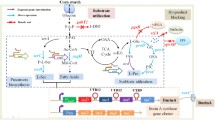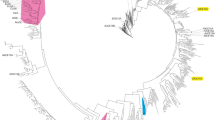Abstract
The possible contribution of collateral enzymes to the formation of the key precursor metabolite, 3-hydroxybutyryl-CoA, has been evaluated in a recombinant Escherichia coli strain engineered for 1,3-butanediol biosynthesis from glucose via the inverted fatty-acid beta-oxidation pathway. Inactivation of the 3-hydroxyadipyl-CoA dehydrogenase gene, paaH, did not prevent 1,3-butanol biosynthesis during anaerobic glucose utilization by a strain with an intact, essential gene, fabG. This gene encodes 3-ketoacyl-ACP reductase, which can catalyze the conversion of acetoacetyl-CoA to (R)-3-hydroxybutyryl-CoA. The subsequent inactivation in the strain of the fadB gene, which encodes (S)-stereospecific 3-hydroxyacyl-CoA dehydrogenase of the fatty-acid beta oxidation led to the cessation of 1,3-butanediol synthesis. The respective diol was also not found among the products secreted by the strain possessing the intact fabG and paaH genes upon the individual deletion of the fadB gene. It was established that the collateral enzymes did not participate in the formation of 3-hydroxybutyryl-CoA in the studied strains, and the respective CoA derivative was synthesized solely by the (S)-specific enzyme of the fatty-acid beta-oxidation pathway. The results indicate that reversal of the fatty-acid beta oxidation pathway can ensure the enantioselective biosynthesis of the (S)-stereoisomer of 1,3-butanediol in engineered E. coli strains.
Similar content being viewed by others
REFERENCES
Aguilar, A., Twardowski, T., and Wohlgemuth, R., Bioeconomy for sustainable development, Biotechnol. J., 2019, vol. 14, no. 8. e1800638. https://doi.org/10.1002/biot.201800638
Stereoselective Biocatalysis, Patel, R.N., Ed., New York: Marcel Dekker Inc., 2000.
Rosen, T.C., Daussmann, T., and Stohrer, J., Bioreduction forms optically active 3-hydroxyesters, Spec. Chem. Mag., 2004, vol. 24, no. 4, pp. 39–40.
Chen, G.Q. and Wu, Q., Microbial production and applications of chiral hydroxyalkanoates, Appl. Microbiol. Biotechnol., 2005, vol. 67, no. 5, pp. 592–599.
Ren, Q., Ruth, K., Thony-Meyer, L., and Zinn, M., Enantiomerically pure hydroxycarboxylic acids: current approaches and future perspectives, Appl. Microbiol. Biotechnol., 2010, vol. 87, no. 1, pp. 41–52. https://doi.org/10.1007/s00253-010-2530-6
Lee, S.Y. and Lee, Y., Metabolic engineering of Escherichia coli for production of enantiomerically pure (R)‑(–)-hydroxycarboxylic acids, Appl. Environ. Microbiol., 2003, vol. 69, no. 6, pp. 3421–3426. https://doi.org/10.1128/aem.69.6.3421-3426.2003
Park, S.J., Lee, S.Y., and Lee, Y., Biosynthesis of (R)‑3-hydroxyalkanoic acids by metabolically engineered Escherichia coli,Appl. Biochem. Biotechnol., 2004, vol. 113–116, pp. 373–379.
Kataoka, N., Vangnai, A.S., Tajima, T., et al., Improvement of (R)-1,3-butanediol production by engineered Escherichia coli,J. Biosci. Bioeng., 2013, vol. 115, no. 5, pp. 475–480. https://doi.org/10.1016/j.jbiosc.2012.11.025
Kataoka, N., Vangnai, A.S., Ueda, H., et al., Enhancement of (R)-1,3-butanediol production by engineered Escherichia coli using a bioreactor system with strict regulation of overall oxygen transfer coefficient and pH, Biosci. Biotechnol. Biochem., 2014, vol. 78, no. 4, pp. 695–700. https://doi.org/10.1080/09168451.2014.891933
Nandedkar, A.K. and Kumar, S., Biosynthesis of fatty acids in mammary tissue. II. Synthesis of butyrate in lactating rabbit mammary supernatant fraction by the reversal of beta-oxidation, Arch. Biochem. Biophys., 1969, vol. 134, no. 2, pp. 563–571.
Dellomonaco, C., Clomburg, J.M., Miller, E.N., and Gonzalez, R., Engineered reversal of the β-oxidation cycle for the synthesis of fuels and chemicals, Nature, 2011, vol. 476, pp. 355–359. https://doi.org/10.1038/nature10333
Clomburg, J.M., Vick, J.E., Blankschien, M.D., et al., A synthetic biology approach to engineer a functional reversal of the β-oxidation cycle, ACS Synth. Biol., 2012, vol. 1, pp. 541–554. https://doi.org/10.1021/sb3000782
Gulevich, A.Y., Skorokhodova, A.Y., Sukhozhenko, A.V., et al., Metabolic engineering of Escherichia coli for 1‑butanol biosynthesis through the inverted aerobic fatty acid β-oxidation pathway, Biotechnol. Lett., 2012, vol. 34, no. 3, pp. 463–469. https://doi.org/10.1007/s10529-011-0797-z
Kim, S., Clomburg, J.M., and Gonzalez, R., Synthesis of medium-chain length (C6-C10) fuels and chemicals via β-oxidation reversal in Escherichia coli,J. Ind. Microbiol. Biotechnol., 2015, vol. 42, pp. 465–475. https://doi.org/10.1007/s10295-015-1589-6
Gulevich, A.Y., Skorokhodova, A.Y., Sukhozhenko, A.V., and Debabov, V.G., Biosynthesis of enantiopure (S)-3-hydroxybutyrate from glucose through the inverted fatty acid β-oxidation pathway by metabolically engineered Escherichia coli,J. Biotechnol., 2017, vol. 244, pp. 16–24. https://doi.org/10.1016/j.jbiotec.2017.01.009
Gulevich, A.Yu., Skorokhodova, A.Yu., Stasenko, A.A., et al., Metabolic engineering of Escherichia coli for 1,3-butanediol biosynthesis through the inverted fatty acid-oxidation cycle, Appl. Biochem. Microbiol., 2016, vol. 52, no. 1, pp. 15–22. https://doi.org/10.1134/S0003683816010051
Taguchi, K., Aoyagi, Y., Matsusaki, H., et al., Co-expression of 3-ketoacyl-ACP reductase and polyhydroxyalkanoate synthase genes induces PHA production in Escherichia coli HB101 strain, FEMS Microbiol. Lett., 1999, vol. 176, pp. 183–190. https://doi.org/10.1111/j.1574-6968.1999.tb13660.x
Zhang, Y.M., Wu, B., Zheng, J., and Rock, C.O., Key residues responsible for acyl carrier protein and beta-ketoacyl-acyl carrier protein reductase (FabG) interaction, J. Biol. Chem., 2003, vol. 278, pp. 52935–52943. https://doi.org/10.1074/jbc.M309874200
Park, S.J. and Lee, S.Y., Identification and characterization of a new enoyl coenzyme A hydratase involved in biosynthesis of medium-chain-length polyhydroxyalkanoates in recombinant Escherichia coli, J. Bacteriol., 2003, vol. 185, pp. 5391–5397. https://doi.org/10.1128/JB.185.18.5391-5397.200320
Babu, T., Yun, E.J., Kim, S., et al., Engineering Escherichia coli for the production of adipic acid through the reversed β-oxidation pathway, Process Biochem, 2015, vol. 50, pp. 2066–2071. https://doi.org/10.1016/j.procbio.2015.09.018
Sambrook, J., Fritsch, E., and Maniatis, T., Molecular Cloning: A Laboratory Manual, 2nd ed., New York, USA: Cold Spring Harbor Laboratory Press, 1989.
Katashkina, Zh.I., Skorokhodova, A.Yu., Zimenkov, D.V., et al., Tuning the expression level of a gene located on a bacterial chromosome, Mol. Biol. (Moscow), 2005, vol. 39, no. 5, pp. 719–726.
Datsenko, K.A. and Wanner, B.L., One-step inactivation of chromosomal genes in Escherichia coli K-12 using PCR products, Proc. Natl. Acad. Sci. U. S. A., 2000, vol. 97, no. 12, pp. 6640–6645. https://doi.org/10.1073/pnas.120163297
Gulevich, A.Yu, Skorokhodova, A.Yu., Ermishev, V.Yu., et al., A new method for the construction of translationally coupled operons in a bacterial chromosome, Mol. Biol. (Moscow), 2009, vol. 43, no. 3, pp. 505–514.
Gulevich, A.Yu., Skorokhodova, A.Yu., Morzhakova, A.A., et al., 1-Butanol synthesis by Escherichia coli cells through butyryl-CoA formation by heterologous enzymes of Clostridia and native enzymes of fatty acid β-oxidation, App. Biochem. Microbiol., 2012, vol. 48, no. 4, pp. 344–349.
Zhang, Y. and Cronan, J.E., Transcriptional analysis of essential genes of the Escherichia coli fatty acid biosynthesis gene cluster by functional replacement with the analogous Salmonella typhimurium gene cluster, J. Bacteriol., 1998, vol. 180, no. 13, pp. 3295–3303.
Teufel, R., Mascaraque, V., Ismail, W., et al., Bacterial phenylalanine and phenylacetate catabolic pathway revealed, Proc. Natl. Acad. Sci. U. S. A., 2010, vol. 107, no. 32, pp. 14390–14395.https://doi.org/10.1073/pnas.1005399107
Funding
The work was supported by a grant from the Russian Foundation for Basic Research (project no.18-29-08059).
Author information
Authors and Affiliations
Corresponding author
Ethics declarations
The authors declare that they have no conflicts of interest.
This article does not contain any studies involving animals performed by any of the authors.
This article does not contain any studies involving human participants performed by any of the authors.
Additional information
Translated by I. Gordon
Abbreviations: ACP—acyl carrier protein; HPLC—high performance liquid chromatography; IPTG—isopropyl-β-D-thiogalactoside; PCR—polymerase chain reaction.
Rights and permissions
About this article
Cite this article
Gulevich, A.Y., Skorokhodova, A.Y. & Debabov, V.G. Study of the Potential of the Reversal of the Fatty-Acid Beta-Oxidation Pathway for Stereoselective Biosynthesis of (S)-1,3-Butanediol from Glucose by Recombinant Escherichia coli Strains. Appl Biochem Microbiol 56, 822–827 (2020). https://doi.org/10.1134/S0003683820080049
Received:
Revised:
Accepted:
Published:
Issue Date:
DOI: https://doi.org/10.1134/S0003683820080049




